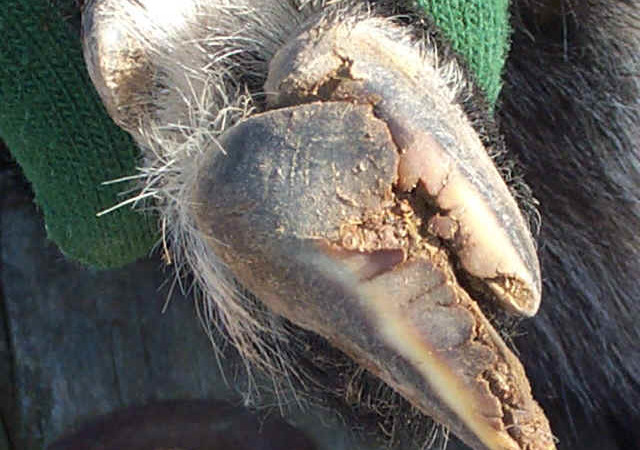

Many foot and leg problems in goats are either caused by a lack of trimming or improper trimming techniques. The amount of time between trimmings depends on many factors, such as type of terrain, the goat’s age, level of activity, nutritional level and even breed. Goats raised in relative confinement and on small acreages may also require more frequent trimmings than goats raised in vast pastures.
Generally, foot trimming should be done on an as needed basis. Once you become familiar with how the hoof is supposed to look, this will become obvious to you. A properly trimmed hoof should look like that of a newborn kid.
The tools for hoof trimming include: gloves, a set of hoof shears and a hoof knife, both with sharp edges. Optional items include: a rasp, some iodine, turpentine, copper sulfate, and formalin.
It is always easier to trim feet after the goats have been outside in wet grass, as the moisture is taken in by the hoof walls, making them softer and easier to trim. There are also commercial preparations that may be used to harden or soften the hoof if one feels that this is necessary.
There are several ways of holding or restraining a goat in order to care for hooves. The best method is whatever works well for your particular situation.
One method is to place the goat on a milking stand. However, most meat and mohair goat producers do not have access to a milking stand nor would their stock stand quietly when placed on such a stand. Therefore, a more practical method might be to merely tie the goat to a post or fence with a halter or have someone hold the goat while the feet are being trimmed. Hold the goat’s feet in the same fashion as a farrier works on a horse.
Another method that can be used involves placing the goat between one’s legs in the same position used for shearing; that is, the animal is in an upright sitting position. This method has the advantage that if the trimmer must work alone without the aid of a milk stand, he/she still can restrain goats better than when they are tied somewhere but do not like to stand still. This method works best with angora and mohair type goats, since they are shorn in this position, however; dairy and meat goats unused to this position may fight quite a bit.
How trimming is done
The first step in trimming is to clean off the foot, so that it is free of dirt, stones, rot and manure. Besides being easier to see and more pleasant to handle, a clean foot will not dull a knife’s edge as fast as a dirty foot.
The next step is to remove any rim or excess growth from the walls of the foot. The wall may have grown and folded back under the foot. In this case some of the overlapped toe will have to be cut back so that the rim of the wall can be removed properly.
The trimming of the wall and toe should be done with the shears, while the heel and sole can best be cut with a hoof knife. When using a hoof knife, always cut away from the goat and yourself. The sole should be trimmed down in thin slices until the heel, sole and wall form a flat surface upon which the goat should stand at a correct angle of about 45o.
Stop trimming as soon as the sole begins to appear a pinkish color. Any further trimming goes into the ”quick” and the foot will begin to bleed. In that case, a disinfectant such as iodine should be used. Turpentine will harden the sole and may also be helpful. In many cases, the weight of the goat itself will put pressure on the cut and stop the bleeding.
 Contact Jaguza Support
Contact Jaguza Support